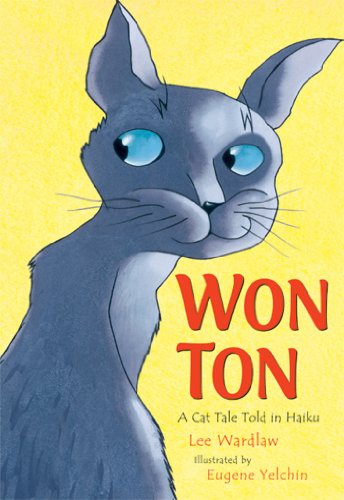Simple, direct, and intense, haiku are descriptive nature poems written in the present tense (here and now). They contain a fleeting natural image and an aha! moment when something unexpected happens – a surprise ending. The goal is for the reader to experience the moment in a new way.

A haiku consists of three phrases that include a seasonal reference (kigo) and are joined with a ‘cutting word’ (kireji). The form was popularized by the Japanese poet Matsuo Bashō (1644–1694). One of the most famous haiku poems is Bashō’s Frog Haiku. There are many English translations of the poem; here are three:
Old pond — frogs jumped in — sound of water.
ancient is the pond —
suddenly a frog leaps — now!
the water echoes.
Breaking the silence
Of an ancient pond,
A frog jumped into water —
A deep resonance.
We see two juxtaposed images from nature – an ancient silent pond and a jumping frog. We hear the sound of the splash into the water (the surprise ending).
Japanese haiku poems were translated into English and French at the beginning of the 20th century and became popular by the middle of the 20th century. Today, these short image poems are among the most popular poetry forms in the world.
While English haiku are most often written as three lines where the middle line is longer, Japanese haiku frequently appear as a single line. When this happens in English, the poems are often called monoku.
Because the form became so popular with English poetry classes, there are a lot of books written in 5 – 7- 5 haiku. Many well-known children’s writers have written books with haiku for kids. Jane Yolen’s Least things: poems about small natures is a collection of 14 haiku poems illustrated with photos by her son, Jason Stemple, depicting small animals like snails and frogs. Haiku are also included in many of her poetry collections – Eek, you reek!, An Egret’s Day, An Alligator’s Smile all include haiku.
Jack Prelutsky’s If not for the cat: Haiku (pictures by Ted Rand) includes 17 haiku riddles from the point-of-view of various animals: “If not for the cat/And the scarcity of cheese,/I could be content.” Prelutsky includes haiku in some of his other poetry books as well, like Hard-Boiled Bugs for Breakfast: and other tasty poems (illustrated by Ruth Chan; Greenwillow Books, 2021).
H Is for Haiku: A Treasury of Haiku from A to Z by Sydell Rosenberg illustrated by Sawsan Chalabi. This haiku ABC book teaches children to observe and captures precious moments of life in the city – moments in nature and moments in humanity.

Bob Raczka shares boyhood fun through the seasons from his own life and that of his sons in Guyku: A Year of Haiku for Boys “Icicles dangle/ begging to be broken off / for a short sword fight.”
Two examples of seasonal riddles written in haiku style: Lion of the Sky: Haiku for all seasons by Laura Purdie Salas ill by Merce Lopez). “I’m cold confetti / falling from a crystal sky / blanketing the lawn.” Guess Who, Haiku by Deanna Caswell illustrated by Bob Shea asks preschoolers to guess what the haiku is about: “sitting for a treat / an eager tail smacks the ground / over and over.”
Wing nuts: screwy haiku by Paul B. Janeczko and J. Patrick Lewis ; illustrated by Tricia Tusa is a collection of haiku puns: “Grumpy bear growl / blends with chirp of rusty hinge: Mom and Dad snoring.”


Won Ton: A Cat Tale Told in Haiku and Won Ton and Chopstick: A Cat and Dog Tale in Haiku, both by Lee Wardlaw.
Won Ton is about a shelter cat who gets adopted; in the sequel, Won Ton gets a housemate when a dog enters the home.
“Visiting hours!
Yawn. I pretend not to care.
Yet — I sneak a peek.”
Wabi Sabi / by Mark Reibstein ; [illustrations] by Ed Young is a story about a cat named Wabi Sabi who searches for her name.
Three haiku books with holiday themes are:
- Boo! Haiku by Deanna Caswell, illustrated by Bob Shea – a Halloween-themed collection of haiku riddles for young children.
- Santa Clauses: short poems from the North Pole by Bob Raczka (offers a fresh, fun perspective on Santa’s December preparations.
- Hanukkah haiku by Harriet Ziefert ; paintings by Karla Gudeon. celebrates the eight nights of Hanukkah through haiku.
Haiku is popular, and there are many books I did not include here, including haiku verse novels for older readers. In many of these books, I find the authors stick to the old syllabic definition of haiku, rather than embracing the imagery and simplicity of a moment in time.

Great post, Yvona! Packed with great information!…Gabrielle
LikeLike
Thank you!
LikeLike
What a wonderful post! I inspired me to write more stories in haiku format!
LikeLike
Thank you.
LikeLike